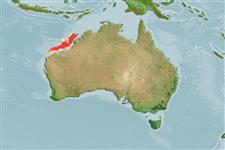Elasmobranchii (sharks and rays) >
Myliobatiformes (Stingrays) >
Urolophidae (Round rays)
Etymology: Urolophus: Greek, oura = tail + Greek, lophos = crest (Ref. 45335).
More on authors: Last & Gomon.
Environment: milieu / climate zone / depth range / distribution range
Ecology
Marine; demersal; depth range 60 - 210 m (Ref. 6871). Deep-water; 15°S - 21°S
Eastern Indian Ocean: Western Australia.
Size / Weight / Age
Maturity: Lm ? range ? - ? cm
Max length : 36.0 cm TL male/unsexed; (Ref. 6871)
Occurs in the outer continental shelf (Ref. 6871, 75154). Size at birth about 10 cm (Ref. 6871).
Life cycle and mating behavior
Maturity | Reproduction | Spawning | Eggs | Fecundity | Larvae
Last, P.R. and J.D. Stevens, 1994. Sharks and rays of Australia. CSIRO, Australia. 513 p. (Ref. 6871)
IUCN Red List Status (Ref. 130435: Version 2024-2)
Threat to humans
Harmless
Human uses
Tools
Special reports
Download XML
Internet sources
Estimates based on models
Preferred temperature (Ref.
123201): 21.1 - 25.2, mean 23.7 °C (based on 16 cells).
Phylogenetic diversity index (Ref.
82804): PD
50 = 0.5000 [Uniqueness, from 0.5 = low to 2.0 = high].
Bayesian length-weight: a=0.00813 (0.00372 - 0.01775), b=3.08 (2.88 - 3.28), in cm total length, based on LWR estimates for this (Sub)family-body shape (Ref.
93245).
Trophic level (Ref.
69278): 3.5 ±0.4 se; based on size and trophs of closest relatives
Resilience (Ref.
120179): Low, minimum population doubling time 4.5 - 14 years (Assuming fecundity<100).
Fishing Vulnerability (Ref.
59153): Low to moderate vulnerability (26 of 100).
